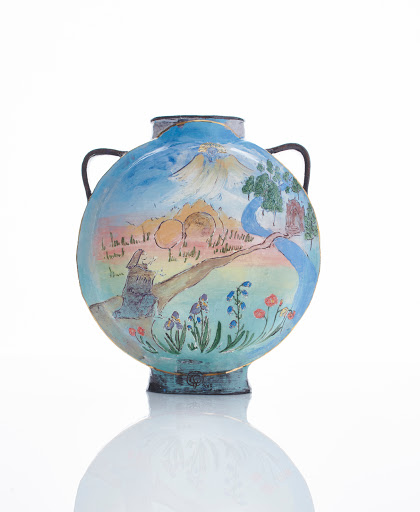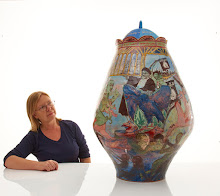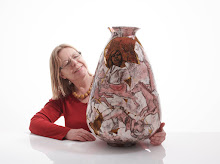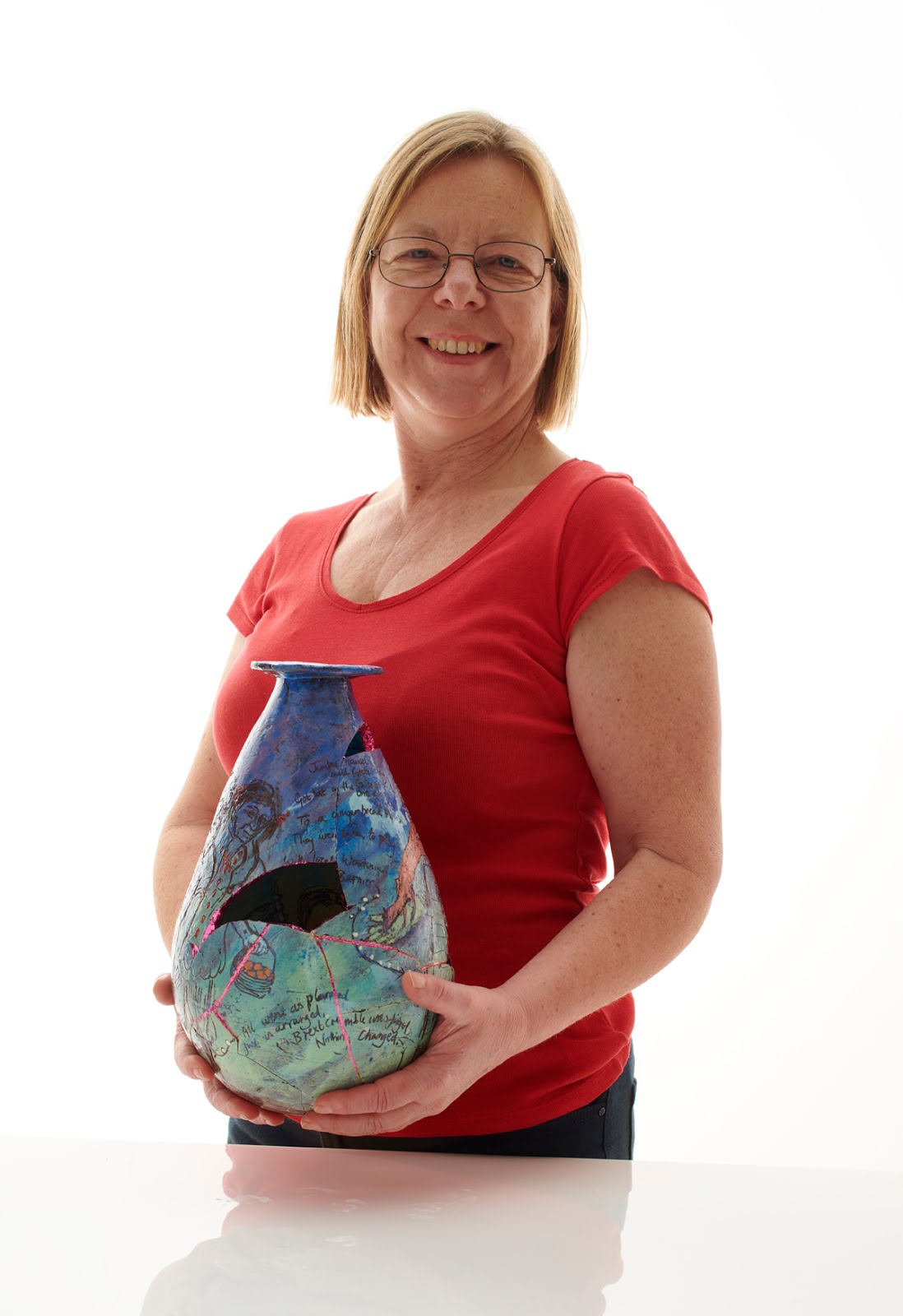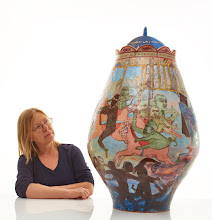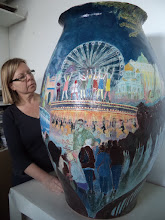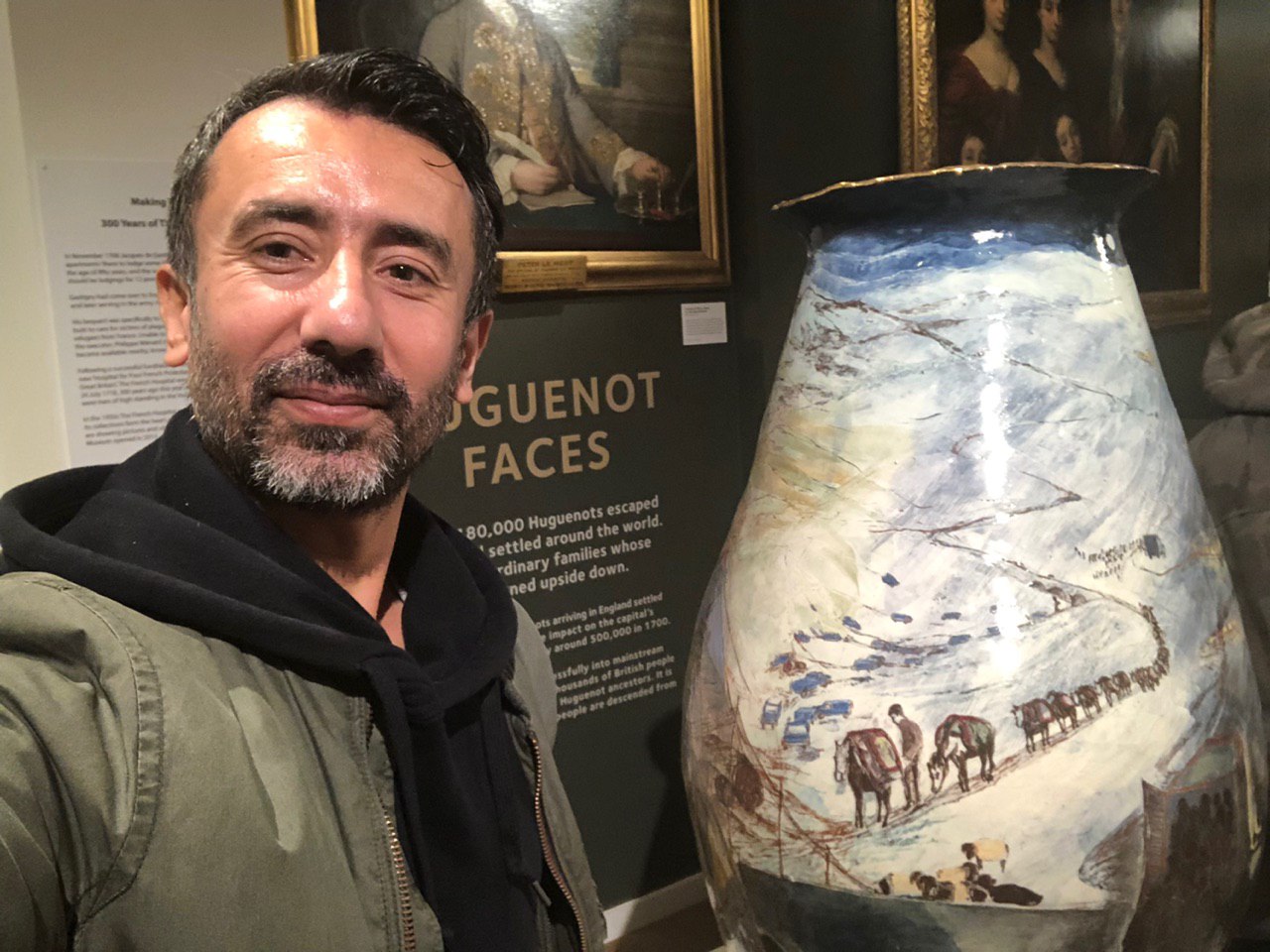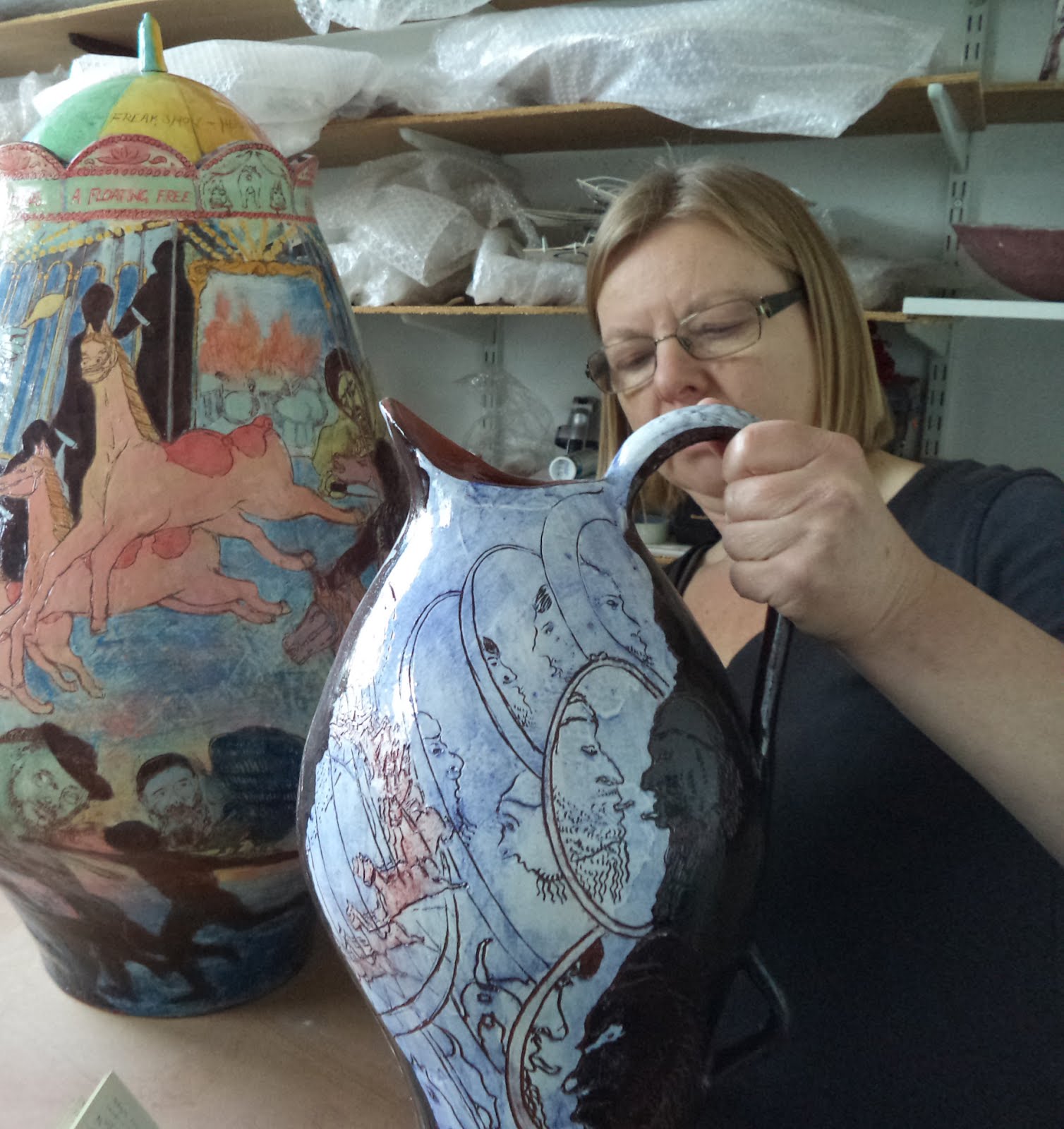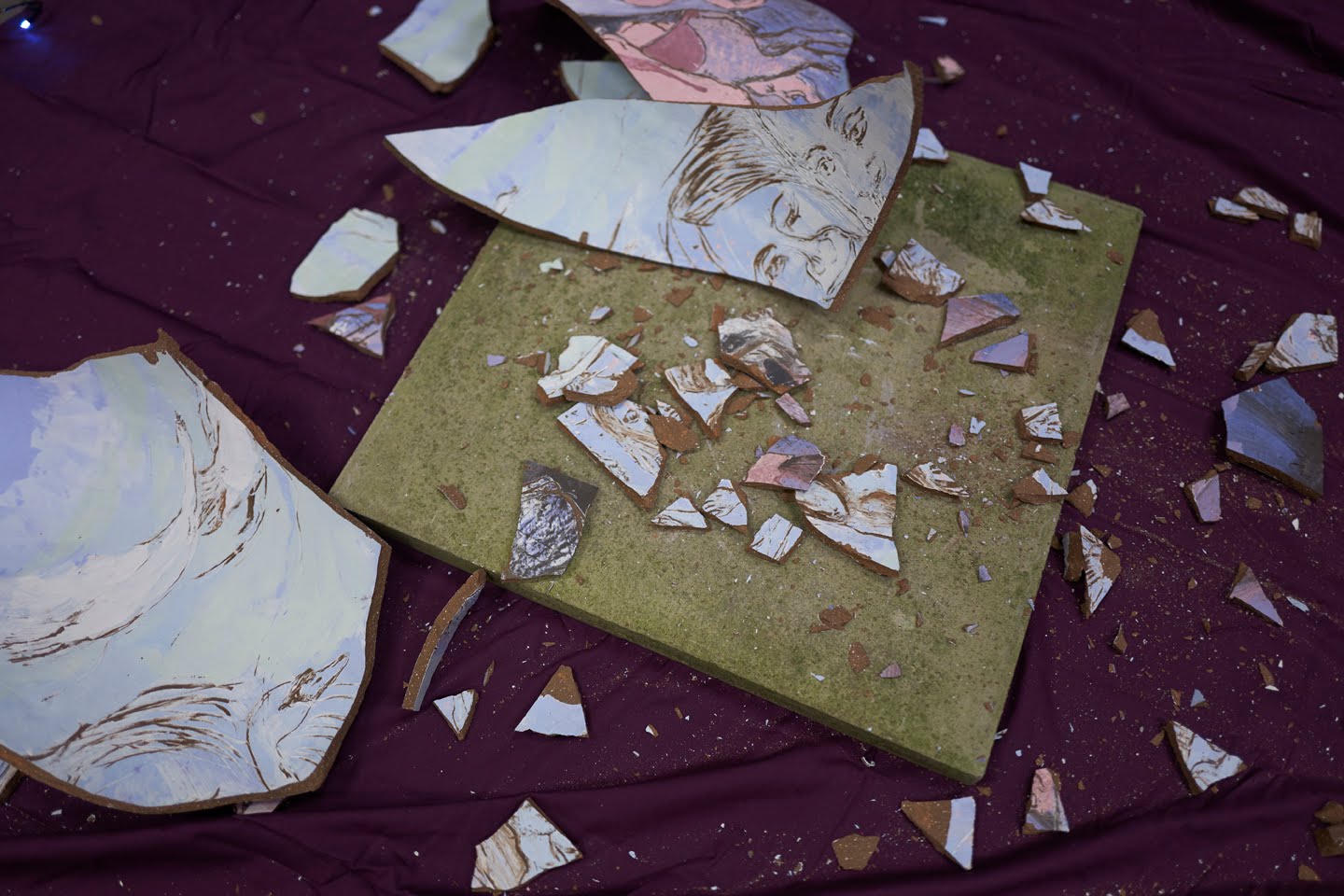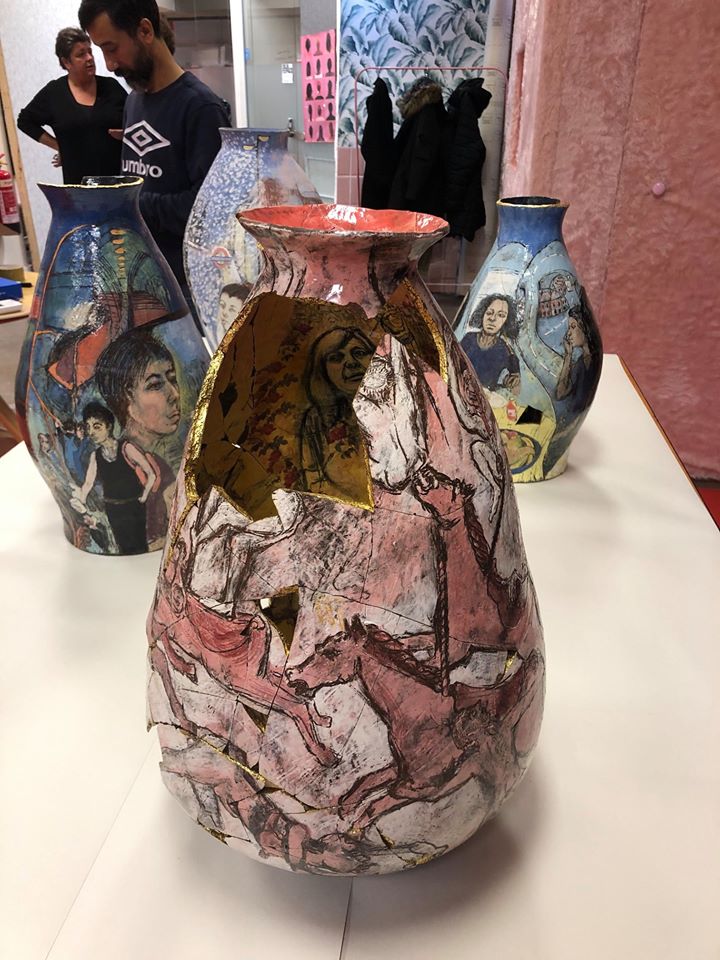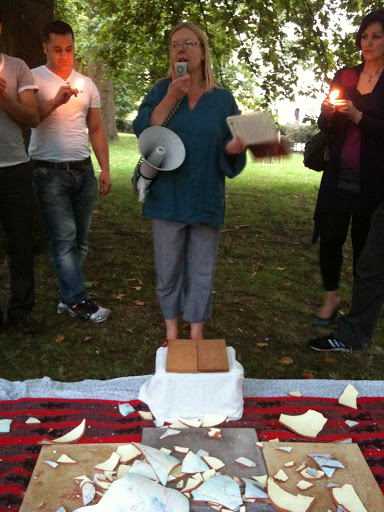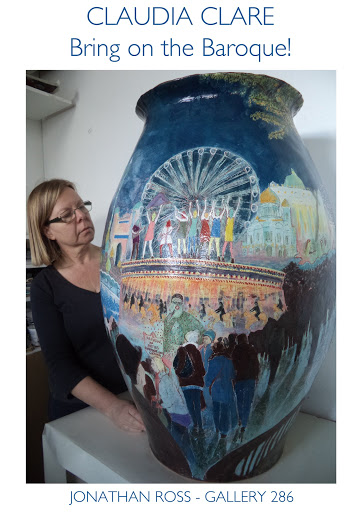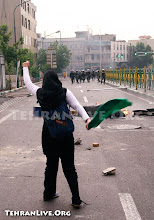The Journal of Modern Craft was launched at The Art Workers Guild on 28th January 2008 in a darkly panelled room bristling with hundreds of portraits of men and one woman. Tanya Harrod (RCA, London) gave a speech and so did Glen Adamson (V&A, London). They are two of the editors of the Journal, the third is Edward S. Cooke from Yale University USA. JMC is billed as, ‘the first peer-reviewed academic journal to provide an interdisciplinary and international forum in its subject area’. Its projected image is SERIOUS. All the pictures are published in black and white – a sure sign of HIGH seriousness - and it’s thoroughly referenced.
Issue 1 includes five articles, a ‘Statement of Practice’, a ‘Primary Text’ and exhibition and book reviews. The ‘Statement of Practice’, in this issue from Simon Starling, reads like a (very) tidied up version of a work-diary, a collection of carefully trimmed and collated notes on things, people and events that interest him and shape his work. The ‘Primary Text’ is an historical text, in this case a lecture by design and architecture critic Rayner Banham from 1973, introduced by Alice Twemlow.
The overall feel of this journal is certainly a good, serious, chewy read. In spite of the presence of the contemporary practitioner’s statement, however, JMC doesn’t feel like a publication that concerns itself with contemporary craft, rather it investigates the Modernist period, which includes, for example, articles about early feminist work from the 1960s and 70s, Polish craft from the early 20th Century and one by Tag Gronberg, which examines the influence of modernist craft and design on Simon Starling’s work and which places his practice within a recognised historical lineage. JMC has a slightly museumy feel to it, which could do with being dusted down and the self-conscious effort to be serious, and therefore be taken seriously by Planet Academia, is probably somewhat over-egged, but may, perhaps, relax with time. There is certainly no slipping into use of the first person, for example, it’s all very proper third person expression, demonstrating the separateness of the researcher/writer from the researched. We are not, at any stage, concerned that the writer may also be a maker, and certainly not the maker of the work being discussed. The supremacy of ‘academic objectivity’ therefore remains uncontested in the carved-stone corridors of the Journal of Modern Craft.
If you’re looking for good writing and (most of the time), good research on craft from the modernist period with a historical perspective, then this is very much for you. If you’re looking for excellent writing on contemporary practice, particularly written by practitioners, then you will be disappointed, and to be fair, the Journal does not, at the moment, set out to cover this territory. There are some illuminating examples, however, of the problem of this sort of ‘objective’ writing, in a couple of the articles, which are worth considering.
The first is in ‘Materials, Skills and Cultural Resources: Onta Folk Art Pottery Revisited,’ (Brian Moeran, pp 35-54). Moeran complains that the potters are ‘uniformly vague about just what the designation of Onta pottery as an Important Intangible Cultural Property actually means,’ (italics mine). The reference attached to this statement cites an exception who, he says, remembers the details of this designation precisely. He goes on to dismiss the potters’ complaint that the (government) Agency that produced the designation didn’t understand their skills and provides the following interpretation: ‘Although there may be some truth in this point of view, this kind of remark may also be understood as a typical self-defence mechanism on the part of potters who can use the theme of “skills” to their own advantage as and when necessary.’ It would take a full-length academic article in itself to unpick this stuff, starting with the concept of meaning in ‘Intangible Cultural Property’, but one has to ask, if one person can articulate the details of what was considered by the Agency to be so specific about Onta pottery that it must be ‘preserved,’ then it is highly probably that they all can. They would, however, be very likely to disagree with each other, and they are very likely to be questioning the need to preserve it anyway, and indeed, what counts as preservation, - see what I mean about lengthy article required - my point is that this is where the weakness of the researcher, an ethnographer and anthropologist in this case, really shows. The nub of the problem here is not the potters being cagey or manipulative, but bad ethnography, or to put it more plainly still, a woeful lack of interviewing skills on the part of the researcher. While there is no guarantee that another potter would be much better as an interviewer, s/he may at least be better equipped with knowledge of the skills to pose more searching questions, or may simply be better equipped to be manipulative in return.
Now, I am no devotee of the notion that ‘experiential knowledge’ is superior, or absolute or is bound always to be more efficient at extracting information but, in Moeran’s article, the potters barely emerge as fully cognisant practitioners at all, rather they appear as objectified currency in a game of mediated national identity. They come across as mysterious rural makers, the classic example of the ‘orientalised (literally in this case) other’. Unfortunately, Potters themselves have amply demonstrated their own capacity to orientalise and patronise themselves and each other, especially rural and/or traditional makers, whether in distant lands or a village down the road and, without doubt, this kind of research is far more dependent on its methodology than on the personal experience of the researcher and it is precisely for that reason that I had hoped for something better in a new Journal that promised to be academically sound.
The second example of the problem of ‘objective writing’ is in the article entitled, ‘Sources of Modernity: The Interpretations of Vernacular Crafts in Polish Design around 1900.’ For me, at first, it was fascinating; I’ve never read anything about Polish craft. Poland to me equals all manner of repressive political regimes, but certainly not craft, design, Tartar mosques or pretty carpets. However as I struggled with seemingly impenetrable Polish spelling, I did begin to notice that, fascinating though it was, it was largely an historical account. I’m still not clear what the argument was, so I handed it over to one of my studio-mates, Anete Deleu Regel, who is Polish, knowing that she, at least, would not be distracted with the need to pour over pronunciation and maps as I was. She read the entire journal and left an note for me, praising JMC to the skies, but with the following caveat:
‘The article about Polish craft at the end did not seem so boring as at the beginning, and I’m very happy to read about my country’s culture here in London.’ (She had commented to me earlier that she thought the article was, ‘a bit basic’.) ‘I am sure that it (JMC) adds definitely a new and very important “flavour” to the “landscape of Crafts”’.
Arguably, it doesn’t matter if the article was mainly just an account. In a country where so little is known about Polish material culture of any historical period, everything is helpful. It was noticeable, however, that Anete knew about all the makers and designers cited in the article which made me think that, in the fullness of time, it would be very healthy if knowledge such as hers, combined with the expertise of the practitioner, could be brought into craft writing. We need this kind of knowledge and rigour, and if JMC is anything to go by, it isn’t always to be found in academic writing. The presence of the maker in JMC, the ‘I’, is felt only through the artist’s statement, which emphasised the sense of the maker as the ‘other’, the subject of proper ‘objective’ research and writing rather than an active intellectual participant in the process of defining and developing craft discourse.
Where the ‘proper academic writing’ approach really excels is in the first article, ‘Fiber Art and the Hierarchy of Arts and Crafts, 1960-1980. Here Elissa Auther builds a real argument concerning the reception or not of craft practices into art’s ontological identity. Auther’s article demonstrates the point that you don’t need a practitioner to research and write articles about craft to avoid the problem of patronising or objectifying the maker and romanticising craft processes. That said, ‘Academic objectivity’ was routed as a myth decades ago and a little less anxiety about academic propriety, may, paradoxically lead to more stringent research practice, more illuminating writing and ultimately, a more rigorous building of knowledge.
This has been a somewhat critical assessment of JMC but please don’t be put off. As Anete also said in her note: ‘This journal is EXCELLENT!’ I’m the bah-humbug correspondent on this occasion. JMC has been very warmly welcomed elsewhere. I freely admit to being protective about writing on ceramics, and I’m disappointed in this one example. The Journal as whole is fascinating and, yes, irritating at times, but it really pulls the reader into its pages and it is immensely stimulating. So, yes I am going to subscribe, and Anete has petitioned the CPA shop in Marshall St. in London to stock it. So go and buy your sample copy, or go to the publishers website here, and get stuck in. Then be critical. Then write.
Monday 26 May 2008
Friday 16 May 2008
Buff presents: Make or Break, a Collaborative Exposure of Clay









It’s been another good week for craft; the second this year. Not bad at all. And this is, in part, due to Buff, 2nd year undergrad students from Camberwell College of Art, London, who produced Make or Break as their end of year show and to the seven cool chicks from Stoke Newington who produced X-hibitionism, see below. The C Word only narrowly avoided missing Buff’s glitzy occasion altogether, but for an email arriving in Sophie’s (studio mate’s) inbox. ‘A one-night extravaganza… ceramics….music… and more’ it announced. Excellent, I thought, and swanned off to investigate further.
Village Underground, the splendidly grand Shoreditch venue they selected, is vast, tall, shapely, with tunnels and big HUGE open spaces, and small concealed spaces and vaults and steps and metal girders near the ceiling you can hang things from. Everything, in short, the ceramicist has ever dreamt of. Bliss.
‘So is this your work?’ I enquired of some beautiful one in long eyelashes and BIG platforms who looked like he’d swept straight out of Club Whatever, ‘It’s all been conceptualised and made collectively,’ he explained, gesturing to the whole gathering of works and people. Pause. Sit up straight. Look straight into his eyelashes, ‘You mean,’ I suggest nervously, ‘you’re subverting the entire degree process?’ ????????????????
‘OH yes’ he assents, huge smile.
Wow, I thought. The C Word was officially IMPRESSED. And still is.
I gazed, watery eyed, at the scene. I was in a corner, at the end of a sort of catwalk runway with Philip/a who was serving ‘shots’ of something red in small white ceramic cups from a large white ceramic bucket. He was all dressed in shiney black and the pots were all ‘dressed’ in shiney white. I looked up at the ‘pregnant’ trapeze artist sitting on a swing, clutching her clay belly, and beyond her to the ‘workshop’ where people were making things out of clay and placing them on plinths. To my left, through an arch, in a lower ceilinged space, were various tea parties, a washing up session and a ‘vent vault’ where the audience was being encouraged to smash plates against the wall. Through another arch, up some steps, were two video screens, and numerous small television screens, taking it in turns to show industrial plate making scenes, a naked man spreading-clay-all-over-a-naked-woman-type scene, more industrial process scenes and so on.
Wandering round in mesmerised circles, I was accosted by a gentleman in dress suit and topper with plate of clay balls inviting me to make something. I think I declined, but I enjoyed watching everyone else, and looking at what they’d made. Completing the circuit, I was in time to witness a change in the swing scene, the sort of pregnant angel on high had fallen (?) not literally, but she’s gone and on the floor, on a white bed, was a pregnant man, clutching his clay belly. Back to the runway of small white cups, and so it went on, an endlessly changing spectacle.
So, woman as vessel, the myth of making man from clay, the act of birthing the creative impulse, Broken, Shattered, Matters domestic, Matters relational, Social objects, it was all there in one show, and yes, I had drunk strong coffee that day, but I wasn’t that high, and, yes, I’ve seen bits of all of these things before, but not all together, not so faultlessly, so immaculately, so assuredly performed, and certainly not in such an intensely theatrical, spectacular, luminous setting. That was what made me feel high. Chutzpah! It was the sheer Chutzpah of it. And, of course, the anti-authorship spirit of the enterprise. There will now be a minute’s LOUD NOISE while we celebrate what collective action can achieve, and then hope the UN manages a bit of collective action in Burma.
Wednesday 14 May 2008
X-hibitionism



X-hibitionism opened at The Gallery, Edwards Lane in Stoke Newington, North London last night and continues until 5.00pm saturday 17th May. The work of seven women is astutely curated by Wendy Haslam and Slavka Jovanovic to produce a highly crafted collective essay on contemporary female angst which is simultaneously laugh-out-loud funny,- see the glorious 'fanny knickers' of Doris Domestic, aka Wendy Haslam,- and the very wry, almost grotesque humour of Jovanovic in 'SCUM', a welcome reference to Valerie Solanas's classic work, The Society for Cutting Up Men.
Dominated by traditionally 'female' craft practices, particularly sewing and 'entertaining skills', which are used to create installation work, it recalls the work of earlier feminist artists, notably Hannah Wilke, Jo Spence and Helen Chadwick. It was an absolute joy to see an exhibition of the work seven women together, collectively articulating often quite complex feminist narrative; although slightly shocking when one realises how rare that is now. Explicit reference to the earlier exponents would have been welcome. X-hibitionism artists would, I think, have gained much from the expanded context. Chadwick, Spence and Wilke all died relatively recently, and very young, from preventable cancers. It is a fitting tribute to their extraordinary contribution to art history.
Thursday 8 May 2008
Lamentation
This was going to be a post about the London Mayoral elections. Shakespearean I thought. ‘For god’s sake let us sit upon the ground and tell sad stories of the death of kings,’ I thought some more. The scene takes place, ‘on the coast of the Thames, City Hall in view.’
“Let’s talk of graves, of worms, and epitaphs;
Make dust our paper, and with rainy eyes
Write sorrow in the bosom of the Earth.
Let’s chose executors, and talk of wills:
And yet not so,- for what can we bequeath,
Save our deposed bodies to the ground?
Our land, our lives, and all are Boris-bloke’s,…”
Thus laments King Ken of Livingstone, Thrice Lord of City Hall,
Who by the vile treachery of the Witney Laird
And his suburban hoards from Henley
With their London pads,
Is once again deposed
To plot anew…..
But who comes here?
(enter: unknown ragged hoards, urban foxes - not from Henley, tousled swans, assorted water foul and swarm of flies.)
Fox, grinning broadly:
Good my Liege, fear not,
The red-coat hunters will never breach the bounds of our fair city!
Much ruffling of feathers among water foul. Ducks muttering darkly to one another and keeping a distance from red-coated hunter already in their midst.
Swan steps forward, clears throat:
Earl Fox, your gracious forbearance has been noted in this matter, and is gratefully acknowledged by my ladies in waiting, however, (voice begins to tremble slightly), we cannot be certain of the intentions of the urban hunter, not all of whom wear red coats. The Eastern Allies of the Henley Hoards have already plucked (she gulps, tears in her eyes), have already plucked my own good cuz, her Grace the Baroneess Swan of Tottenham from her nesting place in the Lea Valley, and, they say, made of her a banquet. This Boris-Bloke will never put a stop to such foul-treachery, indeed his views on hunting are well known and talked of in the coffee houses of suburbia.
We must repair to the rebel lands of Haringey and there take refuge and prepare to restore Fair City Hall to all who love the Thames and tributaries of London.
Fox, bowing deeply and avoiding eye-contact with ducks:
And so to Haringey, Good Swan, lead on.
Exeunt.
So, it has turned into a post about the treachery of the Henley Hoards
I’ll save the rest for another time. Meanwhile Earl Fox of Tottenham is on my shed roof in the right hand column and a hopeful looking rainbow over The Angel of Tottenham Green, near the den of Seven Sisters in the rebel lands of Haringey.
“Let’s talk of graves, of worms, and epitaphs;
Make dust our paper, and with rainy eyes
Write sorrow in the bosom of the Earth.
Let’s chose executors, and talk of wills:
And yet not so,- for what can we bequeath,
Save our deposed bodies to the ground?
Our land, our lives, and all are Boris-bloke’s,…”
Thus laments King Ken of Livingstone, Thrice Lord of City Hall,
Who by the vile treachery of the Witney Laird
And his suburban hoards from Henley
With their London pads,
Is once again deposed
To plot anew…..
But who comes here?
(enter: unknown ragged hoards, urban foxes - not from Henley, tousled swans, assorted water foul and swarm of flies.)
Fox, grinning broadly:
Good my Liege, fear not,
The red-coat hunters will never breach the bounds of our fair city!
Much ruffling of feathers among water foul. Ducks muttering darkly to one another and keeping a distance from red-coated hunter already in their midst.
Swan steps forward, clears throat:
Earl Fox, your gracious forbearance has been noted in this matter, and is gratefully acknowledged by my ladies in waiting, however, (voice begins to tremble slightly), we cannot be certain of the intentions of the urban hunter, not all of whom wear red coats. The Eastern Allies of the Henley Hoards have already plucked (she gulps, tears in her eyes), have already plucked my own good cuz, her Grace the Baroneess Swan of Tottenham from her nesting place in the Lea Valley, and, they say, made of her a banquet. This Boris-Bloke will never put a stop to such foul-treachery, indeed his views on hunting are well known and talked of in the coffee houses of suburbia.
We must repair to the rebel lands of Haringey and there take refuge and prepare to restore Fair City Hall to all who love the Thames and tributaries of London.
Fox, bowing deeply and avoiding eye-contact with ducks:
And so to Haringey, Good Swan, lead on.
Exeunt.
So, it has turned into a post about the treachery of the Henley Hoards
I’ll save the rest for another time. Meanwhile Earl Fox of Tottenham is on my shed roof in the right hand column and a hopeful looking rainbow over The Angel of Tottenham Green, near the den of Seven Sisters in the rebel lands of Haringey.
Friday 2 May 2008
Swan Song
The telling of the Swan story began, oh who knows, years ago probably. It began for me, as a migration story, about those ‘other’ Romanians. The ones who aren’t us. Who aren’t ‘real’ Romanians. We always argued about that, if we had the energy. Anyway, let’s go back to January. I’m feeling desolate because some kind soul just kicked me in the teeth over a funding application. My new Romanian friend, Vali,’s feeling the same because he’s been abandoned by his housemate and is now homeless. So he turns up at 1.00am, direct from Budapest, with a 2 litre lemonade bottle of plum brandy, and some truly gross-looking sausages. I supplied the bread and the spring onion, and somehow, the depths of self-pity and despair were transformed into a pretty good-natured swapping of scurrilous tales. The next day and at least 150 pictures of his girl-friend later, still in the first week of January, the sun shone warmly, no sign yet of the late snows or frosts that would soon annihilate my jasmine buds, we went for a walk in Finsbury Park. Vali was captivated: ‘We just don’t have places like this in Romania, we don’t have “parks”.’ ‘These birds, just look at all these birds,’ he repeated, endlessly, genuinely amazed. ‘What do you call those ones, those white one?’ ‘Swans’ I said, ‘with a double-u, suuaans.’ I didn’t know if Romanian had a ‘w’ sound. ‘Swans,’ he repeated, faultlessly, as though he’d been discussing them with the queen all his life.
‘You know when Romanians first started going to other countries, Austria was the first we went to, in large numbers. Well, some Romanians went to Vienna, and they have these big parks there, full of birds like here. Well, those Romanians, they started hunting the birds. One day, they hunted, and caught and ATE a Swan.’
‘No’ I shrieked, peels of laughter,
‘Yes, well, you can imagine how famous we were after that. Oh my GOD.’
‘But they taste disgusting,’ I say, still laughing, ‘they taste fishy.’
Vali looks at me, quizzically, frowning, ‘You’re laughing, Claudia. You think it’s funny?’
‘Well, yes,’ I say, feeling slightly guilty now, ‘ok, so it’s hard luck on the Swan, but… yes…’
Pause. ‘The Austrians they did not find it so.’
With utmost confidence I assured him that English people would find this story uproariously funny and would be impressed with the enterprising Romanians bringing their rural skills to the city.
I hadn’t, of course, reckoned with the Haringey Independent, The London Evening Standard, or the Daily Mail, all of whom suddenly developed not only a sense of humour by-pass but also, in the case of the latter, an unusual lapse of memory concerning the ‘right’ of people to hunt. A week or so ago, I found a copy of a Romanian free newspaper, its front page graced with a picture of a swan, and inside, the full story reprinted not only from the Haringey independent, complete with RSPCA phone number, but also the Austrian story. Whether there has ever been any verification that Romanian migrant workers really did eat the Viennese Swan, I have no idea, but the idea has certainly caught on to the extent that most Romanians believe it, but with one important caveat.
We were contemplating the reasons why the Austrians didn’t find the swan-eating saga funny, and I was cheerfully explaining that the English secretly admired a good hunter, when a teenage boyfriend-girlfriend couple with a dog walked past. ‘She’s gorgeous,’ I muttered, ‘But what the hell is she doing with HIM?’
‘That’s EXACTLY what I was thinking’ gasps Vali, ‘EXACTLY.’ We’re looking at the beautiful young woman, with her scrawny, seriously unappealing boyfriend. ‘He looks like a gypssssy,’ hisses Vali, ‘Bloody swan-eaters.’
‘
‘You know when Romanians first started going to other countries, Austria was the first we went to, in large numbers. Well, some Romanians went to Vienna, and they have these big parks there, full of birds like here. Well, those Romanians, they started hunting the birds. One day, they hunted, and caught and ATE a Swan.’
‘No’ I shrieked, peels of laughter,
‘Yes, well, you can imagine how famous we were after that. Oh my GOD.’
‘But they taste disgusting,’ I say, still laughing, ‘they taste fishy.’
Vali looks at me, quizzically, frowning, ‘You’re laughing, Claudia. You think it’s funny?’
‘Well, yes,’ I say, feeling slightly guilty now, ‘ok, so it’s hard luck on the Swan, but… yes…’
Pause. ‘The Austrians they did not find it so.’
With utmost confidence I assured him that English people would find this story uproariously funny and would be impressed with the enterprising Romanians bringing their rural skills to the city.
I hadn’t, of course, reckoned with the Haringey Independent, The London Evening Standard, or the Daily Mail, all of whom suddenly developed not only a sense of humour by-pass but also, in the case of the latter, an unusual lapse of memory concerning the ‘right’ of people to hunt. A week or so ago, I found a copy of a Romanian free newspaper, its front page graced with a picture of a swan, and inside, the full story reprinted not only from the Haringey independent, complete with RSPCA phone number, but also the Austrian story. Whether there has ever been any verification that Romanian migrant workers really did eat the Viennese Swan, I have no idea, but the idea has certainly caught on to the extent that most Romanians believe it, but with one important caveat.
We were contemplating the reasons why the Austrians didn’t find the swan-eating saga funny, and I was cheerfully explaining that the English secretly admired a good hunter, when a teenage boyfriend-girlfriend couple with a dog walked past. ‘She’s gorgeous,’ I muttered, ‘But what the hell is she doing with HIM?’
‘That’s EXACTLY what I was thinking’ gasps Vali, ‘EXACTLY.’ We’re looking at the beautiful young woman, with her scrawny, seriously unappealing boyfriend. ‘He looks like a gypssssy,’ hisses Vali, ‘Bloody swan-eaters.’
‘
Subscribe to:
Posts (Atom)
